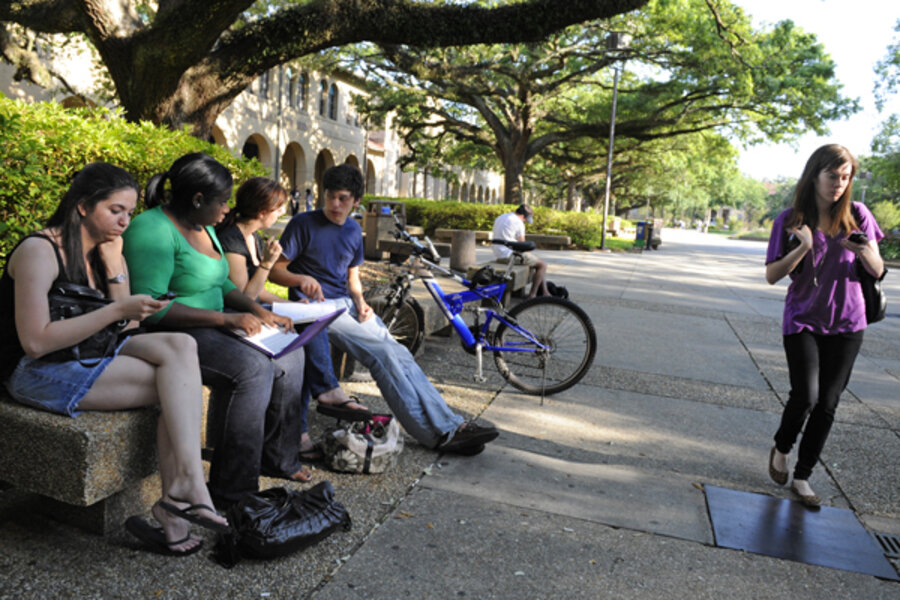Tuition at public colleges jumps 8 percent, College Board reports
Loading...
Tuition at public college and universities continued its steep upward climb this year, rising an average of nearly 8 percent at four-year institutions.
Thanks to federal stimulus funds to the states and a massive influx of federal student aid, students’ wallets didn’t feel such a huge pinch. But the recession is taking its toll.
It’s harder for families to find the means to pay for college, of course. But it’s also becoming increasingly difficult in hard-hit states for campuses to shield students from the effects of budget cuts – everything from bigger classes to the elimination of entire academic programs.
Monitor List: Tired of student loans? These schools will leave you with little debt.
“You would like to think that schools were just quickly finding ways to cut costs without affecting educational quality, but that’s certainly not the case,” says Sandy Baum, an independent analyst for The College Board and co-author of its new report, "Trends in College Pricing 2010."
“We have to figure out a way to educate a lot more students in a cost-effective way without having either the states or the federal government or the families go broke, and that’s a long-term project.”
Just over one-third of American undergraduates attend public four-year colleges and universities, where published tuition and fees now average about $7,600 for in-state students, up 7.9 percent over last year, according to the annual report. Total costs, including living expenses, run about $16,000, up about 6 percent.
Where students live and what income level they have has a lot to do with the price they pay for a given college. After grant aid and tax benefits, the average “net price” is actually down from five years ago, to $1,540 a year for tuition and fees at public four-years.
That number would be a lot higher if it weren’t for federal aid. In just one year, Pell Grants to low- and moderate-income students increased by 58 percent, and veterans’ grant aid increased by 131 percent, according to another College Board report released Thursday, Trends in Student Aid.
Yet about a third of college students still pay the full published price for tuition, and they’ve been hit with significant increases year after year. Colleges typically have to spend even more than that to cover the costs of educating students, Ms. Baum says.
Total state spending on higher education has increased about 8 percent in the past decade, but enrollments have risen dramatically – 33 percent at public colleges and universities. So per-student state spending dropped by 5 percent in 2009-10 and 9 percent in 2008-09.
Louisiana’s public colleges and universities have to cut about $35 million from their mid-year budgets, after already facing cuts last year. They’re shortening work weeks, laying off staff, and waiting for the shoe to drop about how much next year’s budget will be squeezed.
Faculty morale is low and “nobody knows how we will be able to deliver a high-quality education,” says Kevin Cope, president of the Faculty Senate at Louisiana State in Baton Rouge. The campus is preparing for cuts next year in the range of 23 to 35 percent.
“Already, a certain number of courses have been canceled and curricula eliminated,” Mr. Cope says of the flagship campus. Fourteen foreign language faculty will not have their contracts renewed, for instance, which means the loss of instruction in such major languages as Japanese and Portuguese.
In Missouri, the state is reviewing academic programs, asking campuses to consider consolidating or eliminating those that produce a very low number of degrees each year.
At the University of Missouri in Columbia, that means 75 programs, many of them at the graduate level, are being scrutinized for possible cuts. They range from exercise physiology to computer engineering. The review is part of a broader agenda by Gov. Jay Nixon (D) to make higher education more cost-effective as enrollments rise.
“In some respects [that kind of review taking place on many campuses] is one of the silver linings in a recession – that people are forced to make choices ... and then when you emerge from a rocky period, you’re stronger,” says Paul Lingenfelter, president of the State Higher Education Executive Officers in Boulder, Colo.
But the larger issue of pent-up demand for affordable higher education still looms, he says. “Somehow we’ve got to figure out a way to get both the provision of education and the financing of education in sync with the needs of students and the needs of the economy.”





